
Daegu, formerly spelled Taegu and officially Daegu Metropolitan City, is a city in southeastern South Korea.
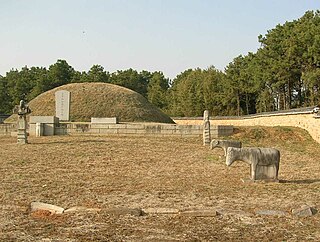
Sangju is a city in North Gyeongsang Province, central South Korea. Although Sangju is rather rural, it is very old and was once a key city. Along with Gyeongju, it gives rise to half of the name of the Gyeongsang provinces. Sangju is nicknamed Sam Baek, or "Three Whites", referring to three prominent agricultural products rice, silkworm cocoons, and dried persimmons from the area.

Myeong-dong Station is a station on the Seoul Subway Line 4. This station is located in Jung-gu, Seoul.

Gwangjin District is one of the 25 districts of Seoul, South Korea. It is located on the north bank of the Han River on the eastern end of Seoul. The district was split from the neighboring Seongdong District in 1995.

Wondang Station is on Seoul Subway Line 3 in Goyang, Gyeonggi Province. Goyang City Hall is nearby. There is a lot of building work in the area undertaken by SK, Daewoo and other companies; including many apartment complexes, shopping malls and a multiplex cinema.

Daegu station is a station on the Gyeongbu Line and Daegu Metro Line 1 in Chilseong-dong, Buk District, Daegu, South Korea.

Yeungnam University Hospital Station is a station of Daegu Subway Line 1 in Daemyeong-dong, Nam District, Daegu, South Korea. It is located near the Yeungnam University Medical Center, Myeongdeok Market, Korea Buddhism University, Daeguaneumsa Temple and Nam-gu Office.

National University of Education Station is an underground station of Daegu Subway Line 1 in Daemyeong-dong, Nam District, Daegu, South Korea. It is named for Daegu National University of Education. It is the first station of a city railroad of Daegu connected with this college.
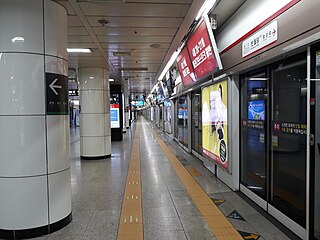
Banwoldang Station is a station of the Daegu Metro Line 1 and Line 2 in Deoksan-dong, Jung District, Daegu, South Korea. Banwoldang Station is the only transfer station of Daegu Metro. Banwoldang underground shopping was created with the second line opening.
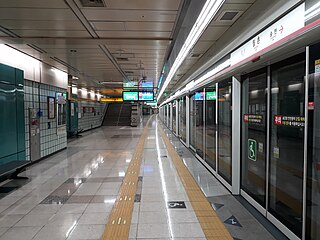
Wolchon Station is an underground of Line 1 of the Daegu Metro in Dalseo District, Daegu, South Korea.

Cheongna Hill Station is a station of Daegu Subway Line 2 and Line 3 in Daesin-dong, Dongsan-dong, and Namsan-dong, Jung District, Daegu, South Korea.
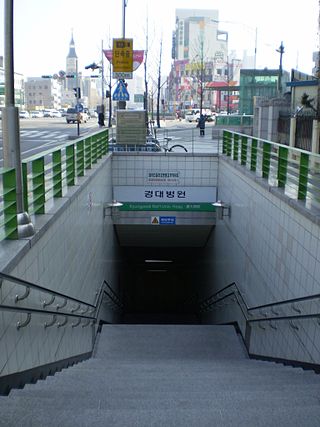
Kyungpook National University Hospital station is a station of Daegu Metro Line 2 in Samdeok-dong, Daebong-dong, Jung District, Daegu, South Korea.

Gosan Station is a station of the Daegu Metro Line 2 in Siji-dong, Suseong District, Daegu, South Korea. While Siji-dong is a single legal dong, Gosan-dong is the administrative dong.
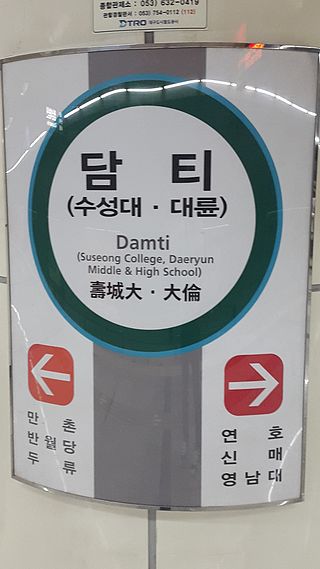
Damti Station is a station of the Daegu Metro Line 2 in Manchon-dong, Suseong District, Daegu, South Korea. It is named after Damtigogae mountain pass and is also called Suseong College and Daeryun High School Station.

Suseong-gu Office Station is a station of the Daegu Metro Line 2 in Beomeo-dong, Suseong District, Daegu, South Korea. Suseong District Office is closer to Beomeo Station than Suseong-gu Office Station.

Daegu Bank Station is a station of the Daegu Metro Line 2 in Suseong-dong, Suseong District, Daegu, South Korea. There are Daegu Bank headquarters around the station.

Namsan Station is a station of Busan Metro Line 1 in Namsan-dong, Geumjeong District, Busan, South Korea.
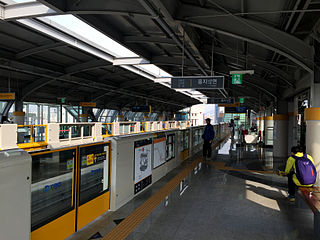
Namsan Station is a station of Daegu Subway Line 3 in Namsan-dong, and Namsanno, Jung District, Daegu, South Korea. It is named after Namsan-dong. Its station subname is Gyemyeongnegeori.

Buk-gu Office Station is a station of the Daegu Metro Line 3 in Wondae-dong, Seo District, Daegu, South Korea.

Yongji Station is a station on the Daegu Metro Line 3 in Beommul-dong, Suseong District, Daegu, South Korea.




















